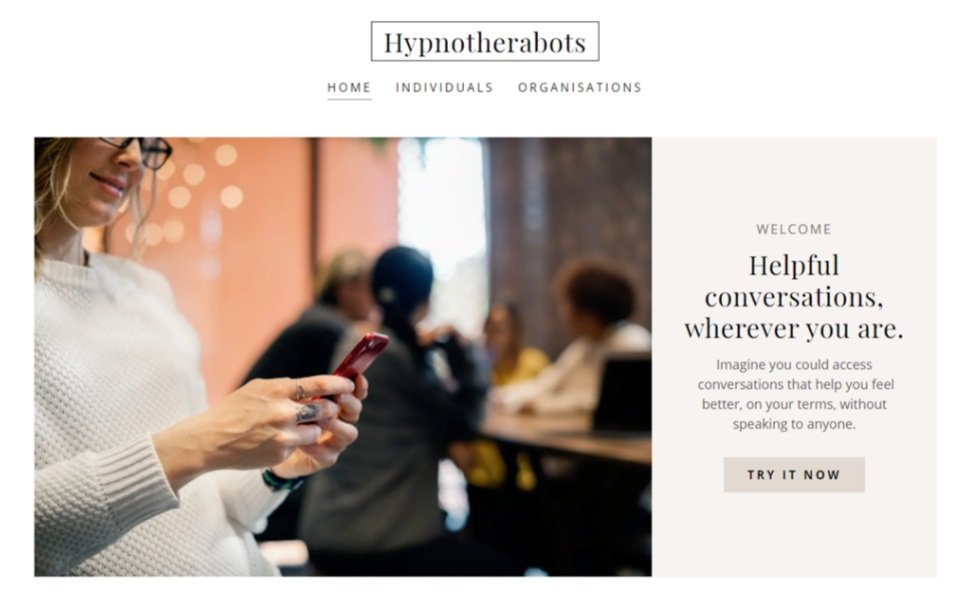
Smartline Research
Newquay Hypnotherapy
How can you extend your reach and grow your client base when you’re working as a sole trader? That was the question that therapist Adam Pearson had for Smartline.
That was the first step on our journey working with Adam to develop an innovative chatbot service for his Newquay Hypnotherapy practice. Here’s how we worked together to develop his ground-breaking new approach to therapy.
“The Smartline team has been extremely supportive and the academics very helpful. This has enabled us to make significant progress into a very innovative area.”
The background
In October 2021 Adam featured in Business Cornwall: https://issuu.com/businesscornwall/docs/bc_oct21
We began our work with Newquay Hypnotherapy by spending time with Adam on a Knowledge Exchange programme. Adam shared his aspirations to extend the reach of his services.
Adam is a qualified and experienced hypnotherapist, who specialises in solution focused hypnotherapy (SFH). This therapeutic approach involves working towards positive outcomes, using the brain’s natural processes.
SFH doesn’t dwell on root causes or the past as some therapies do, so it’s a very positive, forward-looking approach. It works well for people with anxiety, low mood and stress, and can also help people overcome fears and phobias.
Like most talking therapies, Adam’s hypnotherapy sessions take place face-to-face, either in person or via Zoom.
Like many sole traders, Adam had hit a block: there was no room in his working life for expansion to enable him to reach more people. Adam wanted to widen the health benefits of his support.
Could Adam use digital technology to expand Newquay Hypnotherapy’s services? Taking this one step further, was it possible to offer SFH using an interactive online tool?
The opportunity
The next stage was to offer Adam In-Residence support. This would explore how SFH can be self-managed, using technology, to bring wellbeing to a wider audience.
We brought Dr Lexy Newbold onto the In-Residence for her expertise in both SFH and the rigorous evaluation of digital therapies.
Adam was also given access to the university library to search for scientific literature.
“The In-Residence took place over the course of several workshops, meetings and research activities, providing a valuable opportunity for Adam to develop his ideas. This helped him to get a better sense of the product he wanted to produce, the process for getting there, and the market and legal aspects he needed to know. ”
Follow-on support
A screenshot of the chatbot in action.
A follow-on grant helped Adam bring together the necessary technical, marketing and wellbeing expertise to build a Minimum Viable Product (MPV).
Adam was ready to test his prototype, the “Hypnotherabot” with users. This is an automated digital conversational agent (“chatbot”) that enables people to have helpful conversations on their own terms, to help them feel calm, confident and in control. Initial results showed that the mechanisms work, and users like the product in principle.
Refining the chatbot
Having already supported Adam through the initial stages of the Innovation Cycle (Stage 1, Design and Stage 2, Prototype), the natural next step was Stage 3 (Validation).
Further In-Residence support enabled Adam to carry out testing, evaluation and analysis of usage data. How could the chatbot be improved, and what is its therapeutic value?
A crucial area was understanding how Artificial Intelligence (AI) could learn from conversations and become more responsive. Working with Dr Markus Mueller and Dr Tamaryn Menneer from the University of Exeter, Adam discovered that the application of Machine Learning is complex and will need much more work. For now, Adam has decided to keep the chatbot simple.
Adam successfully launches the Facebook-based chatbot which enables users to have solution-focused conversations on their terms, by interacting with an automated chatbot.
The result: a new therapy product
The new chatbot offers people the ability to have a helpful conversation, wherever they are. It’s the perfect approach for people already used to remote and virtual interactions.
Users who engage with the new Hypnotherabot can have a meaningful conversation that makes them feel better, without having to make an appointment or speak to anyone. It can be accessed via smartphone, tablet or computer at any time.
Although there are plenty of apps on the market, and some other practitioners have a chatbot service, the Hypnotherabot is unique. There isn’t another solution-focused, AI therapy out there.
“Not only has Smartline’s support enabled me to realise my aspirations and expand my offer, we’ve also created a unique therapy product. This virtual approach to solution-focused therapy not only extends my audience, it broadens it, reaching those who might not have felt comfortable having face-to-face interaction before.”
Who is involved?
The University of Exeter team supporting this project included Dr Andrew James Williams, Dr Lexy Newbold, Prof Karyn Morrissey, Dr Markus Mueller, Dr Tamaryn Menneer, Stephen Hickman and Emma Seymour.





